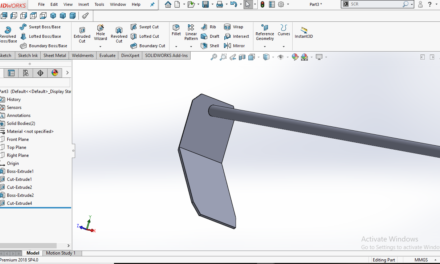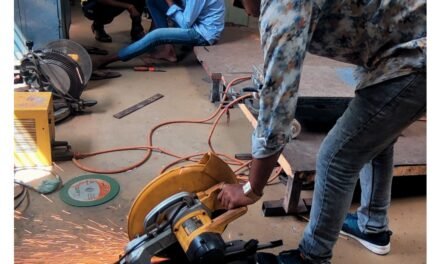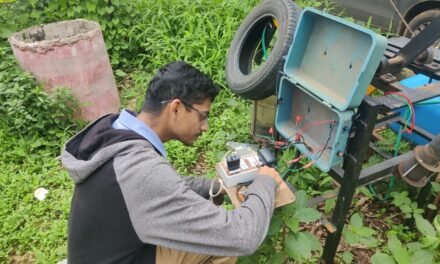Objectives:
1. To set the SOP for tissue culture lab in vigyan ashram.
2. To commercialize the red rose plant.
Need of the Project:
There is a plant tissue culture lab in the Vigyan Ashram campus which is not in the working condition. I need to start working on it and set the SOP for the Rose plant.
Introduction to Plant Tissue Culture:
Plant Tissue Culture is a growing and multiplication of cells, tissues and organs on specific solid or liquid media under aseptic and controlled conditions. This technique is used for large scale plant production. The commercial technology is based on the rapid growth carried out from small stem cuttings, axillary buds and cell clumps in suspension cultures. The main advantage of tissue culture technology lies in the production of high quality and uniform planting material that can be multiplied on a yearly basis under disease-free conditions anywhere whatever is the season and weather. Production of high quality and healthy planting material of ornamentals, and forest and fruit trees, propagated from vegetative parts, has created new opportunities in global trading for producers, farmers, and nursery owners, and for rural employment.
Plant tissue cultures begin with tiny pieces, called explants, taken from any part of a plant. Practically all parts of a plant have been used as a source of explants. In the process, the “explant” is removed from the plant, surface sterilized and placed on a nutrient medium to initiate the mother culture, that is multiplied repeatedly by subculture.
The following plant parts are mostly used in plant tissue culture.
- Shoot-tip and meristem-tip culture
- Nodal or axillary bud culture
- Floral meristem and bud culture
- Cell suspension and callus cultures
The benefits tissue culture:
- Producing disease-free plants
- Improved quality of flowers
- Higher multiplication rate
- Rapid and mass production in less area
- Maintenance of the original genome of the plant and production of hybrid plants as well.
- Production of propagules throughout the year
- Plants can easily be grown off-season
Procedure of Plant tissue culture carried out in lab:
The media involves the following four major components:
- Inorganic nutrient: It includes mineral salts that are important for the growth and development of the plants. It is categorized into two groups: Macronutrients (Calcium, magnesium, nitrogen) and micronutrients (copper, iron, and zinc).
- Organic nutrient: It mainly includes vitamins and amino acids, required for the growth and differentiation of the cultures.
- Growth hormones: It includes auxins, cytokinins, and gibberellins. It is essential for the growth and development of tissues and organs.
- Gelling agents: It includes agar and gelatin. It provides support to the cultures for their establishment.
MEDIA PREPARATION
Preparation of Stock
-
Micronutrients:
- Take 400 ml double-distilled water in a 1L beaker, then weigh the salts given in the table below and dissolve it in the water.
- Transfer the solution to the 1L volumetric flasks, and make up the volume to 1L. Pipette out 10 ml of the solution to make 1L MS media.
|
Salts |
Concentration – 100X (mg/l) |
|
MnSO4.4H2O |
2230 |
|
ZnSO4.4H2O |
860 |
|
H3BO3 |
620 |
|
KI |
83 |
|
Na2MoO4.2H2O |
25 |
|
CuSO4.5H2O |
2.5 |
|
COCl2.6H2O |
2.5 |
-
Iron Stock (20x)
- Take 80 ml double-distilled water in a 100 ml beaker, weigh the components given in the table and dissolve it completely (in the same order as given in the table).
- Transfer the solution to a volumetric flask of 100 ml and makeup to the final volume.
- Pipette 5 ml of the stock solution for 1L of MS media.
|
Components |
Concentration-20X (mg/100 ml) |
|
Na2EDTA |
672 |
|
FeSO4.7HO |
556 |
-
Vitamin Stock (100x)
- Take a 100 ml beaker and add 50 ml double-distilled water in it. Weigh the vitamins given in the table below and dissolve it completely in the water.
- Transfer the solution to a volumetric flask of 100 ml and makeup to the final volume.
- Pipette out 1 ml of the vitamin stock solution for 100ml of MS media.
- Add vitamins after the media is autoclaved to protect it from heat degradation. Vitamins can be sterilized by ultrafiltration technique.
|
Component |
Concentration-100X (mg/100ml) |
|
Glycine |
20 |
|
Nicotinic acid |
5 |
|
pyridoxine.Cl |
5 |
|
Thiamine.Hl |
1 |
-
Cytokinin Stock (100X)
- Weigh “10mg kinetin” and dissolve it into a few drops of 1N HCl.
- Add a few ml of double-distilled water to the above solution and transfer it to the 100 ml volumetric flask and makeup to the volume.
- Store the stock in the refrigerator.
- Use 1 ml of the stock for 1L of the MS media.
Steps of Preparation:
Take a 400ml distilled water in a 1 ltr flask. Weigh the micronutrients given in the table below and dissolve them completely.
|
Macronutrients |
Concentration-100X (mg/L) |
|
(NH4)NO3 |
1650 |
|
KNO3 |
1900 |
|
CaCl2.2H2O |
440 |
|
MgSO4.7H2O |
370 |
|
KH2PO4 |
170 |
- From the prepared stock solutions, pipette out 5ml iron, 10 ml micronutrient, and 1ml kinetin to the 1L beaker of the media.
- Weigh 100 mg Myo-inositol and dissolve it in the previous mixture.
- Weigh 10 mg IAA and dissolve it into a few drops of 1N NaOH. Then, transfer the solution to the previous mixture.
- Add 800 ml of distilled water in the beaker and adjust the pH of the media to 5.7.
- Transfer the prepared solution to a 1L volumetric flask and make up the final volume to 1L.
- Keep the solution in the refrigerator.
Final steps
- Sterilize all the equipment and glass culture jars used for the tissue culture process.
- Weigh 0.8g of supreme grade agar and 3.0g reagent-grade sucrose and transfer them to 250 ml Erlenmeyer flask.
- Add 100 ml of the stored MS media, in the flask and seal the cap with aluminum foil.
- Sterilize the flask with the media.
- After sterilizing the media for 15-20 minutes, add 1 ml vitamin solution.
- Swirl the flask for the dissolution of the vitamin, agar, and sucrose into the media, before pouring it into the culture bottles.
- Pour the media into culture jars and store them in the refrigerator for 1 hour, before the culturing process.
Following table shows the concentration of the nutrients:
| Inorganic salt | mg/L |
| NH4NO3 | 1,650.00 |
| KNO3 | 1,900.00 |
| CaCl2 (anhydrous) | 332.20 |
| MgSO4 (anhydrous) | 180.70 |
| KH2PO4 | 170.00 |
| FeSO4.7H2O | 27.80 |
| H3BO3 | 6.20 |
| MnSO4.H2O | 16.90 |
| ZnSO4.H2O | 5.37 |
| KI | 0.83 |
| Na2MoO4.2H2O | 0.25 |
| CuSO4 (anhydrous) | 0.016 |
| CoCl2 (anhydrous) | 0.014 |
| Sucrose | 30,000.00 |
Preparation of a Sterile Transfer Chamber and Equipment:
Clean the laminar air flow with the acetone. Wrap the forceps, scalpels, razor blades, paper towel and gloves in aluminum foil, seal with tape and sterilize by processing them in a autoclave at 15PSI.
Plant Preparation:
Plant material must first be surface-sterilized to remove any bacteria or fungal spores present. We aim to kill all microorganisms, but at the same time not cause any adverse damage to the plant material. Wash the prepared plant material in a bleaching water for about 20 minutes. Then clean it with the acetone and again clean with the distilled water twice.
Transfer of Plant Material to Tissue Culture Medium:
Use the sterile equipment for following steps
After surface cleaning of plant material take them out in the laminar air flow on paper towels. Then cut the plant materials in parts we want to inoculate in the glass bottle. After that inoculate these explants in the bottle with the help of sterile forceps. At the last close tightly the lid and cover edges of lid with paraffine tape to avoid contamination.
Let the plants grow in an artificial medium
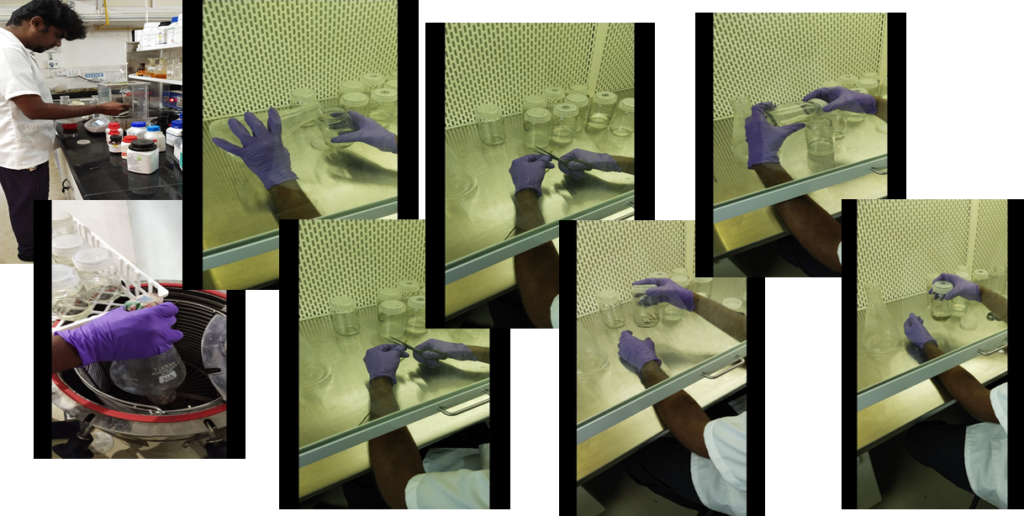
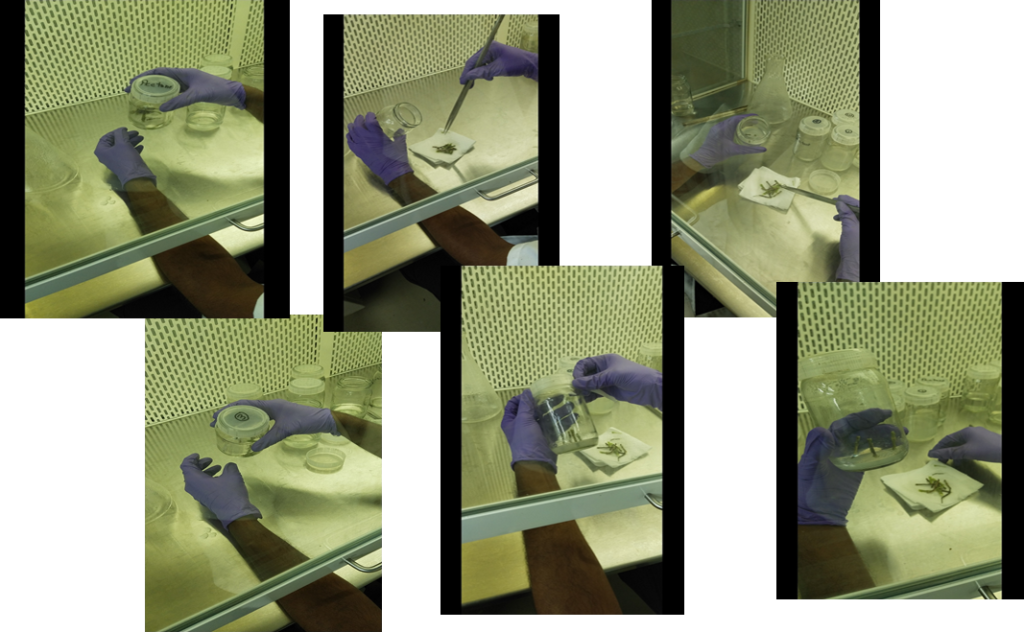
Dec 12, 2021
The media was getting contaminated continuously, there would be fault in sterilization of explants. then we changed the disinfectants from calcium hypochlorite to sodium hypochlorite. We kept the explants in the different concentrations of sodium hypochlorite for different timings and reduced the timing of sterilization.
Jan13, 2021
The timings and concentrations of sterilization are
- In 5% sodium hypochlorite solution for 1min.
- In 4% sodium hypochlorite solution for 2min.
- In 3% sodium hypochlorite solution for 3min.
- In 2% sodium hypochlorite solution for 4min.
- In 1% sodium hypochlorite solution for 5min.
Jan 25, 2021
From this technique we didn’t get contamination for first 9 days after inoculation, but after that it started getting contaminated.
Jan 11, 2021
Then we found that there is always an contamination of fungi after inoculation, so we found a new process in which we have used Bavistin as a fungicide to treat the explants for 20 min. Then we surface sterilized it with the mercuric chloride 5 min. After that again sterilized in 70% ethanol and distilled water.
Feb 21, 2021
From this process we really got very positive results, there is no single explant is contaminated.
Feb 26, 2021
As we found that , the contamination problem has sort for rose plant. so we have to start one more plant which is banana. Now we have started working on banana plant.
March 7, 2021
We have started working on Banana Tissue Culture. We didn’t get banana nodes for the work so we started working on Cann plant, because they both have same regeneration properties. We had planned some tests for the month of March to micro propagate banana plants
March 8, 2021
As we decided to use Cann plants for the micropropagation, the process was…
Sterilization and Media Preparation : The sterilization process of glassware was done in the autoclave, the pressure was 15 PSI and temperature was 121 degree Celsius. We have prepared MS media with the above given proportion
Process of inoculation :
We have used 5% Tween 20 as a surfactant for 20 min, after that 0.1% Bavistin has used as a fungicide, then 0.1% HgCl2 2 min, after that again kept in 70% Ethyl alcohol for 10 sec, lastly washed that explants 2 times with distilled water.
Observation:
From the inoculated 48 rose explants were good in condition and from inoculated 3 cann explants one survived.
March 14, 2021
Sterilization and Media Preparation : The sterilization process of glassware was done in the autoclave, the pressure was 15PSI and temperature was 121 degree Celsius. We have prepared MS media with the above given proportion
Process of inoculation :
We have used 5% Tween 20 as a surfactant for 20 min, after that 0.1% Bavistin has used as a fungicide, then 0.1% NaClo 2 min, after that again kept in 70% Ethyl alcohol for 10 sec, lastly washed that explants 2 times with distilled water.
Observation:
From inoculated 5 explant all were contaminated on 18/03/2021.
March 18, 2021
Sterilization and Media Preparation : The sterilization process of glassware was done in the autoclave, the pressure was 15PSI and temperature was 121 degree Celsius. We have prepared MS media with the above given proportion.
Process of inoculation :
We have used 5% Tween 20 as a surfactant for 20 min, after that 0.1% Bavistin has used as a fungicide, then 0.1% H2O2 2 min, after that again kept in 70% Ethyl alcohol for 10 sec, lastly washed that explants 2 times with distilled water.
Observation:
5 explants which were inoculated got contaminated. The tissue culture done with Mother culture of banana is growing well and having good results. There are 16 explants survived.
March 27, 2021
Sterilization and Media Preparation : The sterilization process of glassware was done in the autoclave, the pressure was 15PSI and temperature was 121 degree Celsius. We have prepared MS media with the above given proportion
Process of inoculation :
We have used 5% Tween 20 as a surfactant for 20 min, after that 0.1% Bavistin has used as a fungicide, then after that again kept in 70% Ethyl alcohol for 10 sec, lastly washed that explants 2 times with distilled water.
Observation:
4 explants which were inoculated got contaminated. The tissue culture done with Mother culture of banana is growing well and having good results. There are 12 explants survived.
March 30, 2021
Sterilization and Media Preparation : The sterilization process of glassware was done in the autoclave, the pressure was 15PSI and temperature was 121 degree Celsius. We have prepared MS media with the above given proportion
Process of inoculation :
We have used 5% Tween 20 as a surfactant for 20 min, after that 0.1% Bavistin has used as a fungicide, then 0.1% AgNO3 2 min, after that again kept in 70% Ethyl alcohol for 10 sec, lastly washed that explants 2 times with distilled water.
Observation:
6 explants which were inoculated got contaminated.
April 07, 2021
Sterilization and Media Preparation : The sterilization process of glassware was done in the autoclave, the pressure was 15PSI and temperature was 121 degree Celsius. We have prepared MS media with the above given proportion
Process of inoculation :
We have sub cultured mother culture of banana explants, in which we have separated those explants from the mother culture and inoculated in the MS media.
Observation:
12 explants are survived.
April 11, 2021
Sub culturing of Rose explants inoculated on 08/03/2021
Sterilization and media preparation:
The sterilization process of glassware was done in the autoclave, the pressure was 15PSI and temperature was 121 degree Celsius. We have prepared MS media with the above given proportion. In the first time the shooting media was prepared, so this time we had prepared rooting media which contained (specifications from lab book). The sterilization was done in autoclave.
Inoculation:
The explants were transferred from the old media bottles to the new media bottles.
Observation :
32 explants are survived. In this media preparation there was no KNO3 available in lab, so we have added KNO3 fertilizer which gave best results i.e. the plants are growing well.
April 17, 2021
Sub culturing of Rose and potato explants inoculated by interns.
Sterilization and media preparation:
The sterilization process of glassware was done in the autoclave, the pressure was 15PSI and temperature was 121 degree Celsius. We have prepared MS media with the above given proportion. In the first time the shooting media was prepared, so this time we had prepared rooting media which contained (specifications from lab book). The sterilization was done in autoclave.
Inoculation:
The explants were transferred from the old media bottles to the new media bottles.
Observation :
10 explants are survived.
April 22, 2021
Sub culturing of banana explants inoculated on 18/03/2021
Sterilization and media preparation:
The sterilization process of glassware was done in the autoclave, the pressure was 15PSI and temperature was 121 degree Celsius. We have prepared MS media with the above given proportion. In the first time the shooting media was prepared, so this time we had prepared rooting media which contained (specifications from lab book). The sterilization was done in autoclave.
Inoculation:
The explants were transferred from the old media bottles to the new media bottles.
Observation :
18 explants are survived.
April 24, 2021
Sub culturing of banana explants inoculated on 27/03/2021
Sterilization and media preparation:
The sterilization process of glassware was done in the autoclave, the pressure was 15PSI and temperature was 121 degree Celsius. We have prepared MS media with the above given proportion. In the first time the shooting media was prepared, so this time we had prepared rooting media which contained (specifications from lab book). The sterilization was done in autoclave.
Inoculation:
The explants were transferred from the old media bottles to the new media bottles.
Observation :
12 explants are survived.
April 25, 2021
Sub culturing of banana explants inoculated on 07/04/2021
Sterilization and media preparation:
The sterilization process of glassware was done in the autoclave, the pressure was 15PSI and temperature was 121 degree Celsius. We have prepared MS media with the above given proportion. In the first time the shooting media was prepared, so this time we had prepared rooting media which contained Stock solution of macronutrients 20ml, Micronutrients 5ml, Vitamin source 10ml and Iron source 5ml. The sterilization was done in autoclave.
Inoculation:
The explants were transferred from the old media bottles to the new media bottles.
Observation :
14 explants are survived.
April 26, 2021
Inoculation of Rose Explants.
Sterilization and Media Preparation : The sterilization process of glassware was done in the autoclave, the pressure was 15PSI and temperature was 121 degree Celsius. We have prepared MS media with the above given proportion
Process of inoculation :
We have used 5% Tween 20 as a surfactant for 20 min, after that 0.1% Bavistin has used as a fungicide, then after that again kept in 70% Ethyl alcohol for 10 sec, lastly washed that explants 2 times with distilled water.
Observation:
58 Explants were inoculated and there is no contamination in it.
April 27, 2021
Separation of all banana explants.
Sterilization and Media Preparation : The sterilization process of glassware was done in the autoclave, the pressure was 15PSI and temperature was 121 degree Celsius. We have prepared MS media with the above given proportion
Process of inoculation :
We have separated the banana explants which were inoculated before.
Observation:
54 Explants were inoculated and there is no contamination in it.
Conclusion of Month of April :
In the month of April we have sub cultured 58 rose and 54 banana explants.
[Photo Gallery]
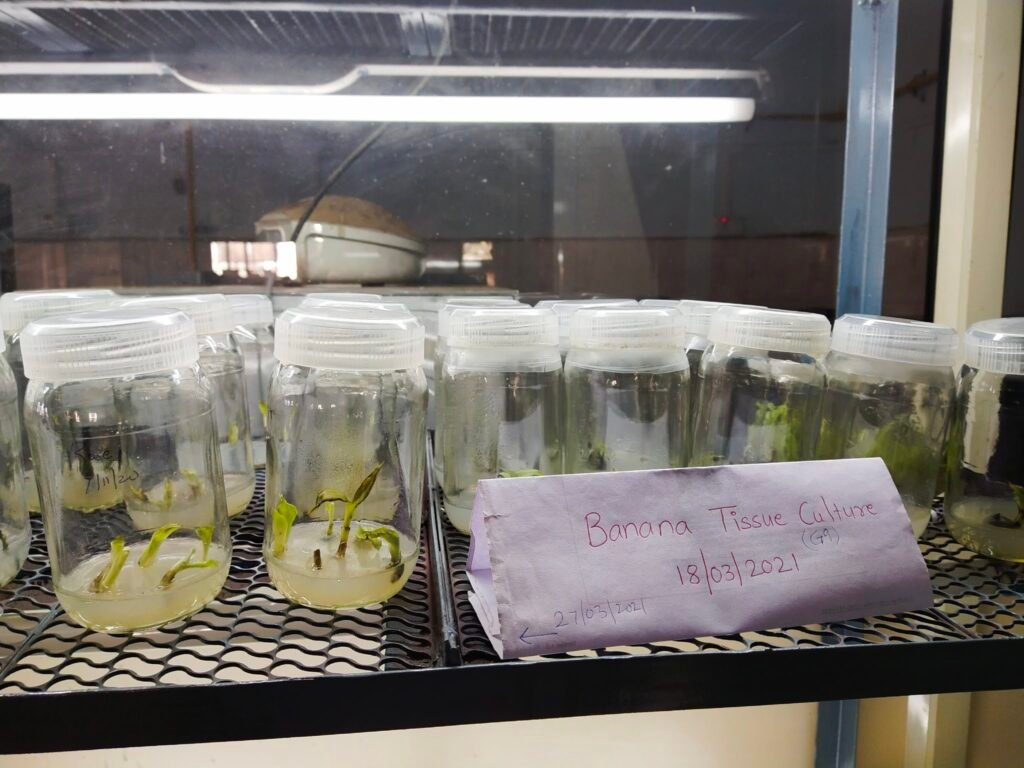
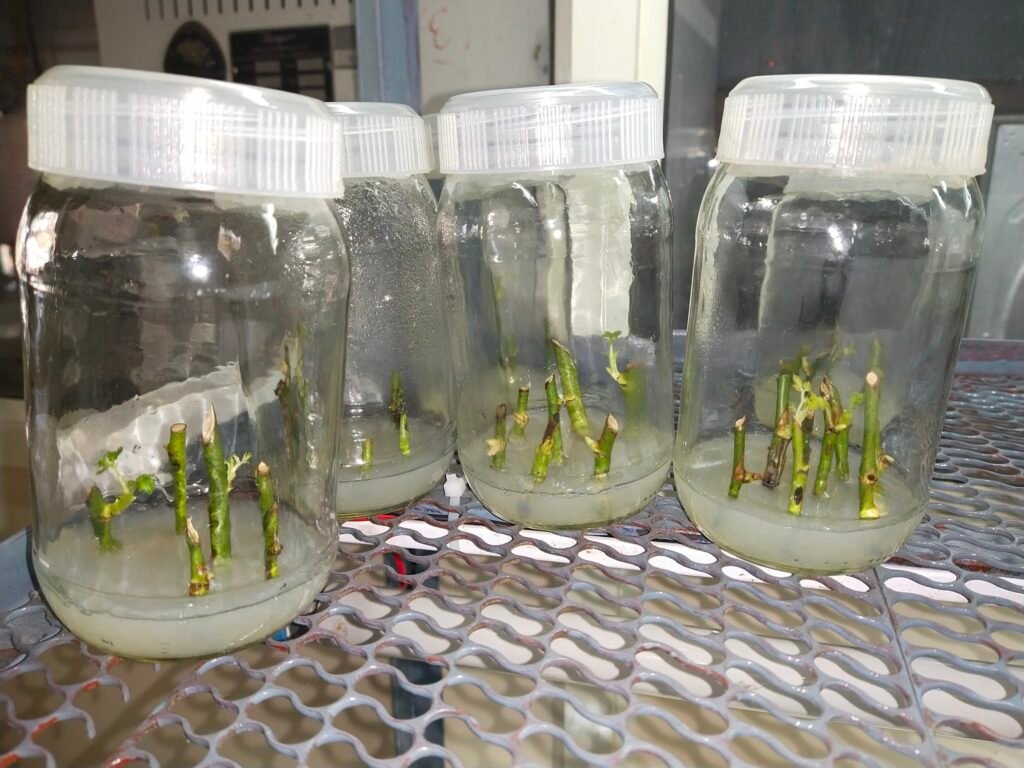

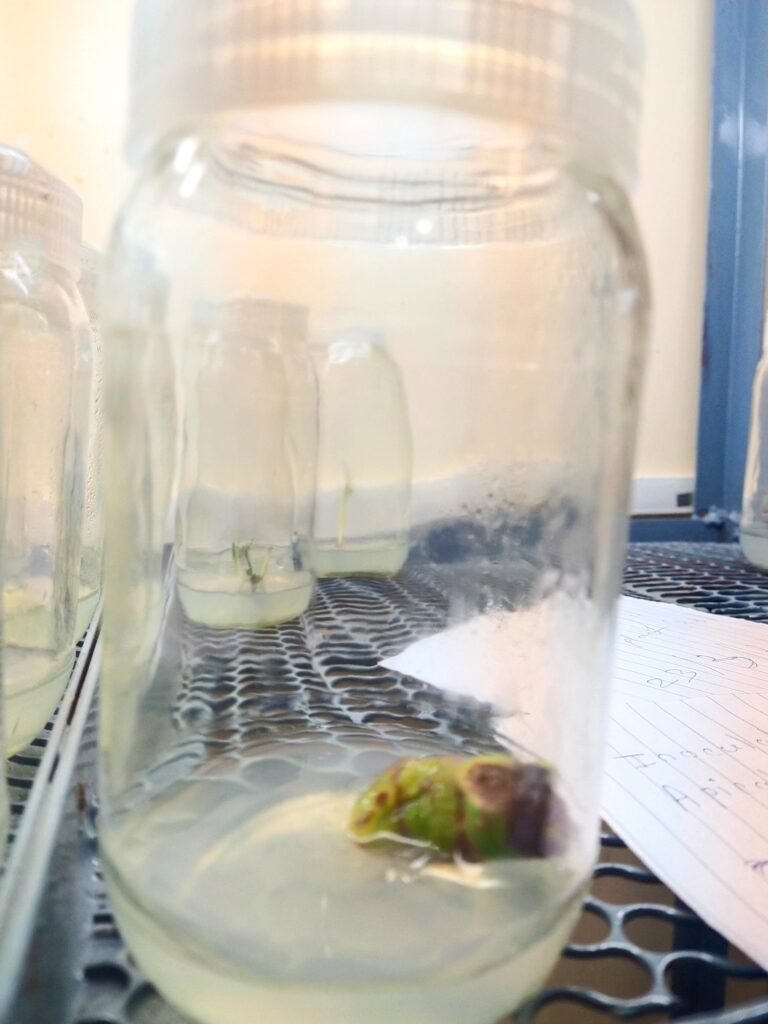
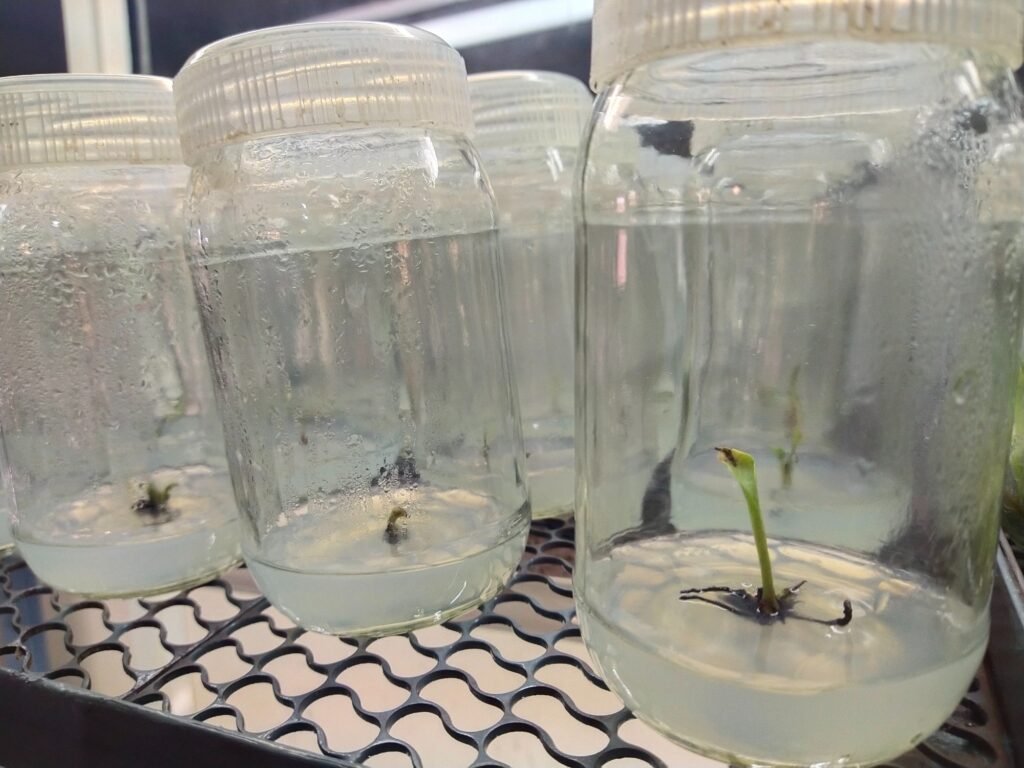
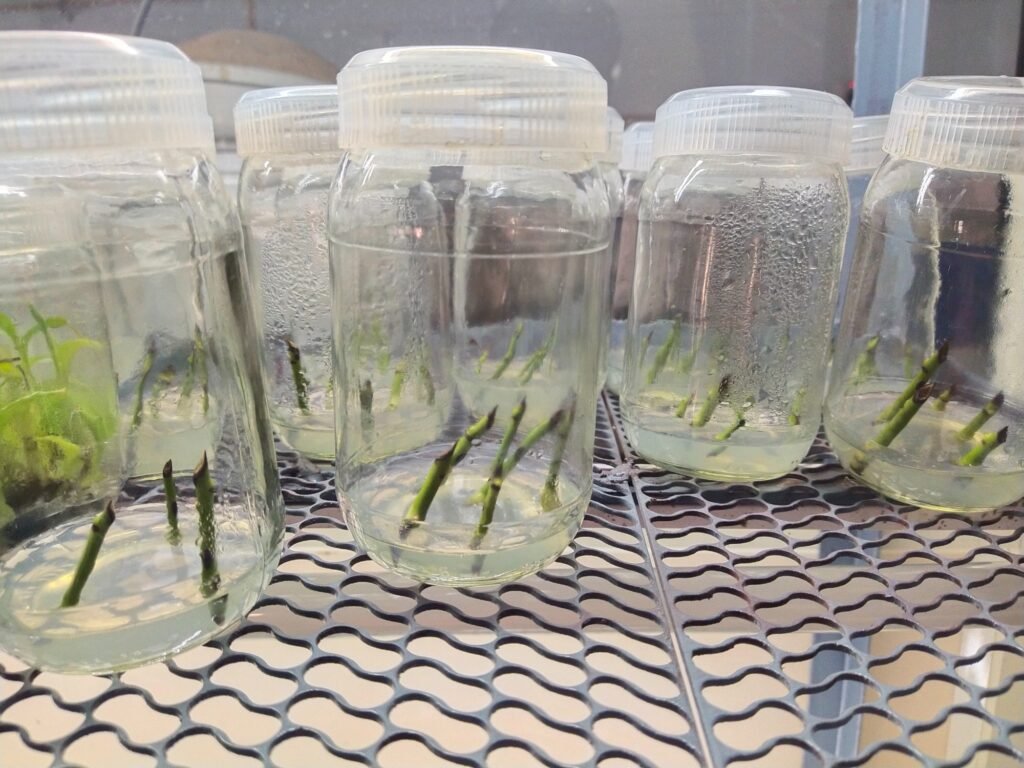
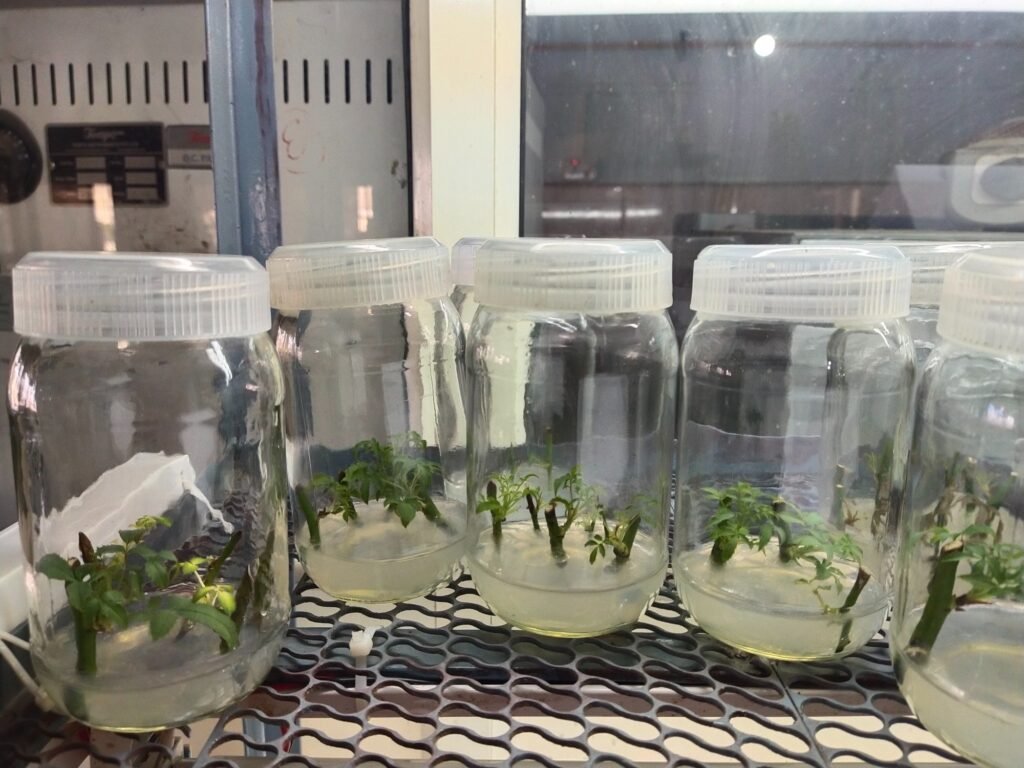
Concluding Note on Plant Tissue Culture:
Initially in the plant tissue culture we were facing problems of media sterilization. On that we have started using Sodium Hypochlorite as a disinfectant with different concentrations and timings. For this method we got best results for bacteria contamination but not on the fungal contaminations.
For fungal contamination we have used Bavistine as a fungicide. As a result the explants stopped contaminating.
From March7,2021, We have started working on the Banana plants.
In the starting we had taken trials on Canna plants. For that we had checked the different surfactants for the sterilization with the fungicide Bavistin. But for that we didn’t succeed. Then we brought the mother culture for banana plant G9 species. From this mother culture we multiplied the explants. Now in the tissue culture lab there are —– explants.
Used SOP for Tissue Culture
Stages of Rose Plant Tissue Culture:
Meristem culture is one of the most popular techniques to produce disease-free plants. In this technique, apical buds or nodal segments are cultured to regenerate multiple shoots.
Following are the stages of Rose Tissue culture
Initiation of aseptic cultures:
It includes the choice of right explant and its surface sterilization to prepare it for the next step. Meristems are suitable to enhance axillary branches. The nodal explant is the most extensively used explant for rose propagation.
Sterilization and Media Preparation :
The sterilization process of glassware was done in the autoclave, the pressure was 15PSI and temperature was 121 degree Celsius. We have prepared MS media with the above given proportion
Process of inoculation :
We have used 5% Tween 20 as a surfactant for 20 min, after that 0.1% Bavistin has used as a fungicide, then 0.1% NaClo 2 min, after that again kept in 70% Ethyl alcohol for 10 sec, lastly washed explants 2 times with distilled water. The Rose Plants should Subcultured after a week till there is no proper growth of explants.

